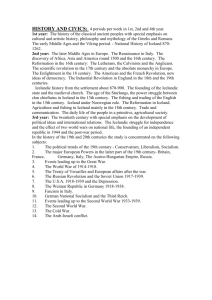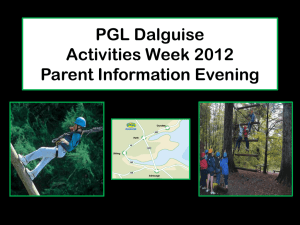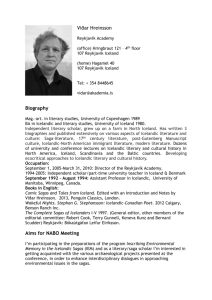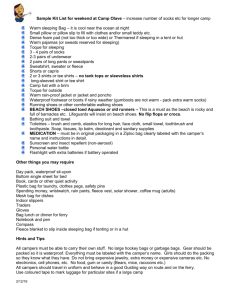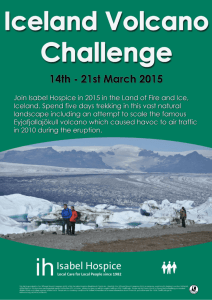Iceland Trek - Withernwick
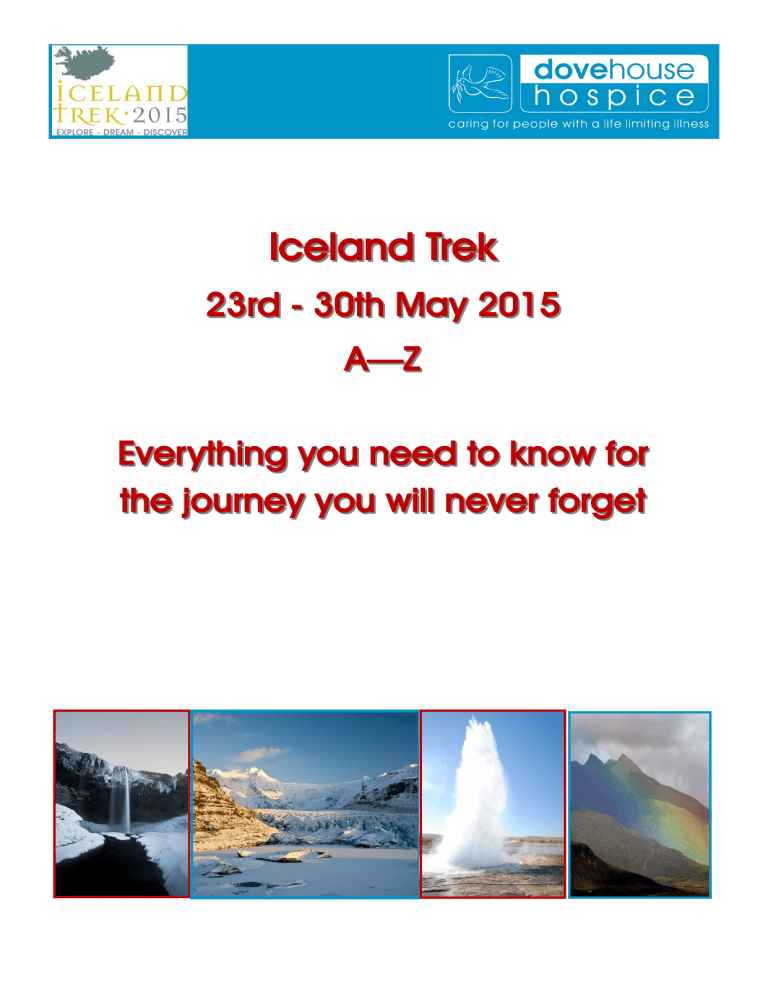
Iceland Trek
23rd 30th May 2015
A — Z the journey you will never forget
Accommodation
You will stay in a hotel in Reykjavík and in mountain huts on the trek.
Arrival
British passport holders do not require a visa to enter Iceland for stays of up to 3 months. Your passport must be valid for a minimum period of three months from the date of entry into Iceland.
Books
Some good reading material to learn more about Iceland includes:
Bradt Guides Iceland (September 2011); ISBN: 978-1841623610; £15.99
Cicerone Walking and Trekking in Iceland (May 2012); ISBN: 978-1852846473; £16.95.
Boots
You will need to wear hiking boots so please ensure you have some well in advance of departure so you can break them in properly. Make sure you have your boots properly fitted at a specialist boot store and make sure you try on lots of pairs before you choose some. The boots should ideally be leather (or leather and synthetic) with high cut to give sufficient ankle support. The sole should be soft but robust such as Vibram.
Gore-Tex or eVent waterproof membranes are recommended.
If you own B1 mountain boots, these would be ideal as there is a chance you may need to use crampons during the trek
(supplied) but you do not need to buy these specially, normal hiking boots will be fine. You are strongly recommended to wear your boots on the plane just in case there are any problems/delays with your luggage.
Bottle
You will need a bottle to carry your own drinking water – up to 3 litres per day. Ideally you will bring a two-litre bottle such as a Camelbak or Platypus hydration system plus a one litre bottle or small flask as a backup (or in case you wish to carry a hot drink or soup during the day.
Camping
For the nights during the trek we will be staying in mountain huts, in mixedgender dormitory style bedrooms. A qualified guide and Different Travel tour manager will be with the group for the duration of the trek. You should bring your own sleeping bag.
Communications
The country code from Iceland to UK is +44. To make phone calls to UK numbers from a mobile you will need to replace the first 0 with +44. When dialling from a public phone you will need to replace the first 0 with 0044.
There is also a widely spread mobile phone network across the country and it is thus quite likely that your mobile phone will work if your phone is tri or quad band. Mobile phones will work on most sections of the trek – right up to the summit, although you cannot charge your mobile on the mountain. Whilst in the hotel there is access to the internet, and cyber cafes and establishments with free WiFi can be found all over Reykjavík.
Clothing
As you will be trekking in cold conditions it is vital that you adhere to the layering system and only wear non-cotton clothing. Cotton clothing can be dangerous to wear in cold conditions because when you sweat the moisture is absorbed by the fibres and retained (rather than forced to evaporate as with technical non-cotton fabrics). This retention of moisture will make your clothes damp and will in turn get cold, potentially dropping your body temperature and leaving you vulnerable to the cold and even hypothermia. You can find good quality technical clothing in all reputable outdoors stores. Check the garment label to ensure that there is 0% cotton. Merino wool is a great alternative to the polyester and nylon technical garments, although it can be expensive. Good quality watertight waterproofs (jacket and trousers) are exceptionally important. Rain can be relentless and getting wet means getting cold (as above).
Please contact info@different-travel.com for more advice.
Day Pack
Throughout the trek your day pack is your responsibility. You should bring a medium sized daypack (25-35 litres) which must be large enough to contain everything you need for the day
(waterproofs, warm layers, lunch, water, camera etc.). Anything not required for the trek can be left in your main suitcase in the hotel in Reykjavík. You must ensure that your rucksack has a hip belt and chest strap and is suitable for hiking. Having a comfortable daypack will make an enormous impact on your ability to trek, so you are recommended to have your pack fitted by a trained professional e.g. at Nomad Travel & Outdoors or Cotswold. Try on lots of daypacks before you buy to find one that fits comfortably. See also L is for Luggage and K is for Kit bag.
Dehydration
This is a potential problem caused by the exertions of the day. You should bring a small supply of rehydration salts with you. You can buy the small packets from chemists in different flavours and just add the powder to the quantity of water mentioned on the packet. You can also purchase electrolyte tablets which you add to your drinking water to turn it into a sports drink to help prevent dehydration before it begins. A recommended brand is called Nuun and is available in outdoors stores and online for around £6 for 12 tablets.
Dietary Requirements
Icelandic food is meat and fish heavy but the majority of special diets, such as vegetarian, vegan, glutenfree etc., can be catered for although choices may be limited to pasta and vegetable dishes. Please ensure that you notify us of any dietary requirements at the time of booking or as soon as possible.
Discount
Nomad Travel have kindly offered a 10% discount against any purchase of kit and equipment online or in-store and 10% discount off vaccinations at their travel clinics. Cotswold Outdoor also offer a fabulous
15% discount off their kit and equipment. You will receive a discount voucher upon booking.
Electricity
Two round prong plug sockets are standard in Iceland, so please take an appropriate European adaptor.
Electricity is 220V. Please note that electricity is limited at the hut.
Environment
The wonderful environment of the Icelandic mountains is also an extremely fragile one. We are extremely environmentally conscious and aim to minimise our impact as much as possible. We encourage trekkers to travel responsibly and take care to leave as little impact as possible. We are well motivated towards eco-friendly practices and carry out all our garbage, apart from that which can be safely and easily disposed of at the campsite. Our aim is to help protect and preserve this beautiful environment for future generations of trekkers to enjoy.
Etiquette
Icelandic people love to chat about the weather and are very proud of their country and nature. As a visitor you are likely to be asked “How do you like Iceland?” on many occasions. Icelandic greetings may seem unenthusiastic but over the top cheerfulness is not considered a standard way of greeting. When bathing in public baths and hot springs you must wash thoroughly first without a swim suit. There is a common belief in Iceland about
‘hidden people’ (huldufólk) or Elves and Dwarves that live in rocks and caves. Scepticism about this belief can be considered rude.
Tipping is not expected in Iceland but is appreciated by your guide. Whaling is active in Iceland and any anti-whaling opinions you may express will be argued against vehemently.
Expenses
Please allow some cash for things like laundry, drinks, personal spending money, personal equipment, souvenirs, tips, optional excursions and lunch on day 7. Around £150-200 in Icelandic Krona will probably be enough but it depends how many drinks and souvenirs you wish to buy! ATMs are widespread throughout but be aware that your bank may charge for overseas withdrawals and transactions and some banks block overseas transactions so inform your bank before departure.
First Aid kit
You should have a small first aid kit of essential items which is for your own personal use. Your tour leader is not allowed to give you medication so you must ensure you have access to your own first aid kit in your daypack.
Suggested items to include: personal prescription medicine, painkillers, plasters/blister plasters, anti-histamine tablets and cream, Imodium (loperamide), rehydration sachets, throat lozenges, decongestant, lip balm with
SPF, antiseptic cream, scissors, zinc oxide tape etc.
Fitness
This tour is classified as challenging for someone of a good general level of fitness (i.e. someone who can comfortably walk for up to 8 hours a day for multiple days, or can run 5k, or cycle 10k etc.). You cannot be too fit for this challenge so everyone should train before departure including walking, cardiovascular workouts and work to improve both your stamina and your ability to walk up and down gradients. This trek will involve hiking over rough terrain, glaciers, through some streams and possibly over snow or ice covered areas.
Terrain will be a variety of steep, moderate and flat terrain which may be slippery underfoot.
Food
Icelandic food is very meat and fish heavy, but extremely fresh and good quality. Imports of sheep products are banned so the lamb that is served comes from the free range animals that are so ‘wild’ they could be considered game meat! Being a small island, fish is a major staple in the Icelandic diet with cod, haddock, monkfish, halibut, salmon and may other types of fish being widely available and delicious. Beef and wild deer is also available and just as healthy and happy as the lambs. Fast food can be found in Iceland, with hotdogs being the nation’s favourite snack! Whale and shark meat is also available in Iceland.
Gloves
Temperatures will be low so you are recommended to bring two pairs of gloves. Warm waterproof and windproof gloves with a liner glove and/or mittens with a liner glove would be suitable.
Head Torch
This is invaluable for finding your way to the toilet in the mountain huts, reading in the evenings etc. The Petzl Tikka headlamp is an example of a very high quality head torch but there are some very good inexpensive head torches available if you shop around. Please ensure you take an LED torch, as ones with bulbs are not bright enough, and bring some spare batteries.
Health
You are advised to seek medical advice at least 8 weeks before travelling to ensure that all appropriate vaccinations are up to date. For general information on vaccinations, visit http://www.fitfortravel.scot.nhs.uk but your GP or travel health professional should be the first stop for an in-depth consultation tailored to your medical history.
Different Travel regrets that we cannot provide medical advice or recommendations on vaccinations you should have. You MUST see your own GP or travel health professional for a personalised medical assessment.
Please note that failure to be adequately vaccinated and protected against diseases can sometimes invalidate travel insurance policies as it is considered that you have not taken necessary precautions. If your GP does not specialise in travel vaccinations, please contact the Nomad Travel Health Clinic. Different Travel and
Nomad have teamed up to offer you a 10% discount on kit and vaccinations (discount code given on booking).
Health Insurance Card
As with all visits within the European Union, you should remember to take a European Health Insurance Card
(EHIC) formerly E111 card, which entitles you to emergency medical treatment on the same terms as Icelandic nationals. Please note that the EHIC is not a substitute for medical and travel insurance. You will still need travel insurance which covers you for medical repatriation, on-going medical treatment or treatment of a non-urgent nature. You can get your free EHIC here: http://www.ehic.org.uk
Hiking Poles
Some people find them very useful as it takes pressure off the knees and can make trekking easier, particularly during the descents. Poles are also useful for river crossings.
Hygiene
There are no showers available so you may wish to bring a small pack of baby wipes to freshen up your hands before lunch or on the evenings where you do not have access to bathing facilities. There are some streams nearby where you can wash (no soap please) but they will be very cold.
Insurance
The Different Travel Company will do everything possible to ensure a safe and enjoyable trip however unexpected things can occur such as your cancellation, delays, medical problems and baggage loss etc. Thus, the purchase of travel insurance for our expeditions, such as a policy from Campbell Irvine, is mandatory and you are advised to organise this at the time of booking to ensure you are covered immediately. Travel Insurance is a cost effective way to protect yourself and your equipment. http://www.campbellirvine.com/asp/quotationChooseSTMT.asp?aid=111
Please note: most travel insurance policies protect you before departure too so it is advised to buy insurance as close to booking as possible to protect the loss of your registration fee as a result of cancellation due to injury, illness etc.
Kit Bag
You will need to bring a small kit bag or rucksack to hold your luggage which will be transported to the hut such as your sleeping bag, spare trek clothes and so on. The kit bag should be soft and flexible (definitely no suitcases) such as a sports holdall.
Language
Icelandic is the national language and is notoriously difficult for a non-native to speak! You will win friends
(and lots of laughs) quickly by trying a few words, especially in the more remote villages you will be visiting.
Here are a few useful phrases & numbers in Icelandic.
Luggage
You will need the following 4 luggage items.
1. A daypack of 25-35 litres capacity which you will carry during the trek. This should have a hip belt and chest strap for optimal comfort and it is recommended that you have this properly fitted at an outdoors store by a trained professional. You will carry your own supply of drinking water, basic first aid kit, waterproofs, warm layers, camera etc.
2. A suitcase or rucksack to hold your entire luggage for when you check in on the airline. This can be left at the guesthouse in Reykjavík with anything not needed for the trek.
3. A kit bag or rucksack which will contain your trek gear. This should not be a suitcase but a soft holdall type bag.
4. A combination padlock to secure your luggage on the plane.
Money
The national currency of Iceland is the Krona (ISK). You can purchase Krona in advance from bureau de changes such as ICE (who usually offer competitive rates), Post Office, Thomas Cook etc. ATMs are found in most cities and villages, though not all ATMs are accessible 24 hours. Icelandic ATMs generally accept all major debit, credit, and cash-only cards. Please contact your bank for information about
ATM fees and inform them of your intention to travel to Iceland to avoid your card being blocked for unusual activity. There are currently approximately 190 Krona to the pound (Dec 2013).
Nibbles
High energy snacks, chocolate and sweets are essential during your trek for energy and a great pick-me-up. Dried fruit, nuts – especially walnuts and almonds, Kendal mint cake, bananas, popcorn, energy bars such as Mulebar, Clif bars, etc.
Phone
You should be able to use your phone in Iceland without any problems (subject to your mobile phone provider terms and conditions). Phone signal in the mountains may be more difficult. Roaming calls may be very expensive.
Photocopies
Remember to leave a photocopy of all your documents
(insurance details, flight numbers, passport, credit/debit cards etc.) with a reliable person in the UK. Should you lose anything you can make a call to retrieve your information.
It is also recommended to scan these documents and email them to yourself too.
Photography
When taking photographs of the local people, it is polite to ask their permission. In museums and galleries please check to ensure you are allowed to take photographs.
Religion
Iceland is a predominantly Lutheran nation (approximately 80% of the population). There are also small populations of other faiths including Protestant, Catholic and Buddhist.
Safety
Iceland is one of the safest countries in the world, with a low crime rate. Few visits to Iceland result in any problems but common sense should be applied in regard to keeping valuables out of sight, locking valuable items in a safe (or leaving them at home) and so on. The highest risk you face in Iceland is being involved in a road traffic accident, but you will be transported using safe transport and experienced local driver. You should not have any involvement with drugs of any kind, as this can lead to heavy fines and/or imprisonment.
Sleeping Bag
You will be sleeping in mountain huts on the trek in mixed-gender dormitory style accommodation. There are mattresses provided but you must bring your own sleeping bag. You will need a ‘4 season’ sleeping bag which has a comfort rating of at least 0°C. It is important that you check that the degrees rating for your sleeping bag is comfort and not extreme. The difference between the two is that the comfort rating is the temperature at which a person in good health, having eaten a hot meal and sleeping in a sheltered environment will feel comfortable. The extreme rating is the temperature at which a person in good health, having eaten and sleeping in a sheltered place will survive.
Synthetic sleeping bags are cheaper to buy but they are bulky and heavier to carry. Down sleeping bags are much more expensive but lighter to carry and pack down smaller. However down sleeping bags are useless if they get wet so it is important that if you choose a down bag you have a waterproof stuff sack to keep it dry. Please contact us for more advice.
Sleeping Bag Liner
A silk or thermal sleeping bag liner is also important as it adds an extra layer of insulation to your sleeping bag but also helps to keep it clean from sweat and dirt. You sweat around 300ml in a sleeping bag each night and without a liner this will absorb into your sleeping bag and will get very smelly. It is also handy to have if you get too hot at night and unzip your sleeping bag, but want to be covered by something.
Socks
It is important that the socks you choose are of good quality, non-cotton and will not slip down or sag in your boots which is one of the main causes of blisters. During your trek you will be wearing your breathable, waterproof boots and so you should wear socks to compliment these. Cotton socks absorb sweat and hinder its evaporation, making them damp and therefore likely to rub against your feet, causing blisters.
Socks containing Coolmax (a brand of polyester), nylon, or
Merino wool all have wicking properties. This means that instead of the fabric absorbing sweat, it pulls it away from the skin for it to evaporate. Socks like this compliment the breathability of your boots, and your feet will stay cool and you will avoid blisters.
Sunglasses
These are important as they will protect your eyes from the sun which can be very bright as it reflects off the snow in the surrounding mountain areas. 100% UV protection is important and polarized lenses are ideal but not essential.
Tickets (or e-tickets)
These will be sent to you 2 weeks before departure.
Tipping
Tipping your guide and driver is not expected but is gratefully received. Please liaise with your tour escort about tipping your guides.
Toilets
You will find that toilet facilities in the hotels will be the familiar flushing sit-down toilet but in the mountain huts compost long drop toilets (without flush) are common place. If you need to use the bathroom whilst on the trek please do not leave toilet paper on the trail; pack it up in sanitary disposal bags and dispose of it at your hut.
Water
Tap water (and even water from some streams) is safe to drink and in fact Iceland offers some of the cleanest water in the world. We always recommend taking at least 2-3 litres of water per person per day to ensure you remain hydrated throughout the day. You may wish to bring some powdered fruit juice or squash with you to make the water more palatable and encourage you to drink. Electrolyte tablets such as NUUN turn water into a sports drink and make the water taste great too!
You must bring your own 2-litre water bottle, plus you are recommended to bring a 1-litre backup bottle or flask for carrying hot drinks.
Weather
The weather is highly unpredictable and highly changeable. There may be snow on the ground during the trek, and rain is quite likely through the mountains.
Warm and good quality waterproof clothing (jacket and trousers) is important, and you must use the layering system for clothing. You can expect cold weather in general but if you are lucky there might be some warm and sunny days, in which case the temperature may rise.
Zinc Oxide Tape
When your boots start to rub against your feet, you can apply zinc oxide tape to the hot spot to stop a blister developing.
Prevention is better than cure!
Packing List
ESSENTIALS
E-tickets
Passport & copy
Money / ATM card(s)
Insurance policy info + EHIC
Books/playing cards
LED head torch + spare batteries
Diary/notebook/pen
Sunglasses (100% UV)
HYGIENE
Shampoo / conditioner
Shower gel/ shave kit / loofah
Toothbrush/toothpaste
Antiperspirant/deodorant
Wet wipes
Toilet paper
Sun cream
Hand sanitizer
Camera + spare batteries
Plastic bags – various sizes
Adaptor 2 round pins (Euro)
Walking pole(s)
CLOTHING
Small travel towel
Feminine care products
FIRST AID KIT
Prescription medicine
Ibuprofen
Casual shoes for sightseeing Paracetamol
Casual clothes for sightseeing Plasters
Slippers for hut (optional)
Hiking/mountain boots
Trek socks & underwear
Non-cotton base layers
Non-cotton t-shirts
Warm jacket
Warm mid layer or fleece
Blister plasters
Imodium (Loperamide)
Rehydration (Electrolade/
Diaralyte)
Muscle rub (tiger balm/Deep
Anti-histamine tablets/cream
Antiseptic cream (e.g. Savlon)
Indigestion remedy (e.g. Gavis-
OPTIONAL
Video camera + charger
Mobile phone + charger
MP3 player/iPod
Neoprene socks
Gaiters
Thermal mat (for lunch stops)
LUGGAGE
Suitcase for checked lug-
Daypack (25-35 litres)
Kit bag (for trek luggage)
Rain cover for daypack
Combination padlocks
EATING AND DRINKING
Energy snacks
1l water bottle e.g.
2l water bottle e.g. Camel-
Electrolyte tablets
(optional)
Small flask (optional)
SLEEPING
Eye mask / Ear plugs
Thermal top and bottoms
Lightweight trek trousers
Waterproof jacket + trousers
Liner gloves + warm gloves
Waterproof over mittens
Warm hat
Buff / Balaclava
Swimwear
Lip balm with SPF protection
Zinc oxide tape
Scissors/tweezers
Throat lozenges (optional)
Decongestant (optional)
Spare glasses/contact lenses
Sleeping bag (comfort of
Sleeping bag liner
Pyjamas or thermals
PLEASE NOTE: This list is just a guideline and is not exhaustive – it does not take into account your personal preference or requirements.
If you have any questions about anything on this packing list, please contact info@different-travel.com for more information.

